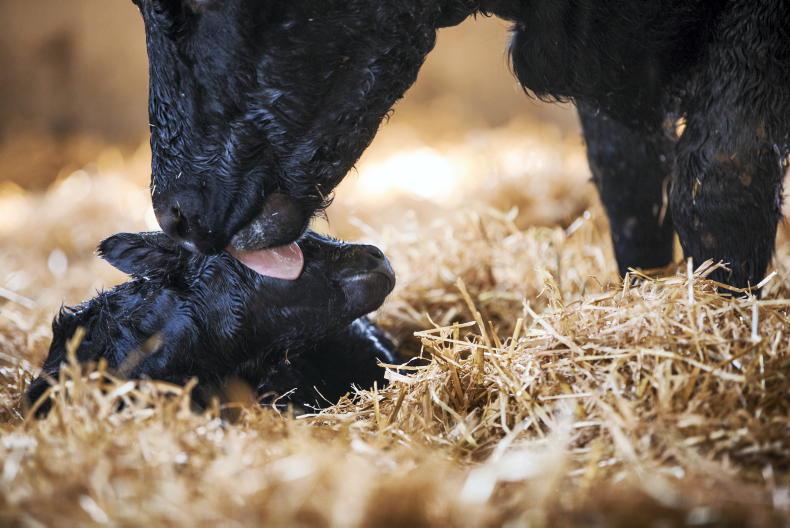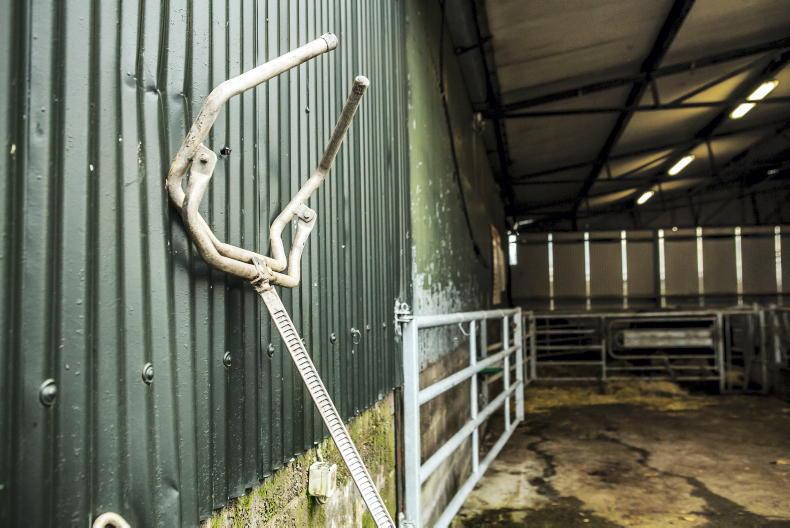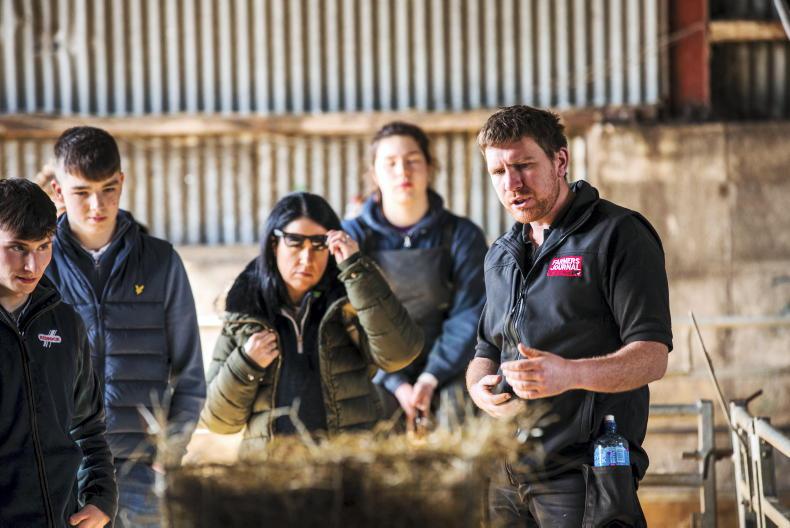It’s the calm before the storm literally this week on Tullamore Farm. The big countdown to calving has begun with the first cow due to calve on 21 January.
Heifers were bred first back in April 2023, with the first 10 animals to calve being heifers.
The start of calving has been pulled back by about a week every year for the last two years.
A new shed constructed in 2022 has meant better facilities for cows and calves after they calve. This means that cows can be calved earlier and moved out to slats and a creep area in advance of turnout.
There are seven cows to calve in January, 40 in February, 20 in March and 15 in April. The idea is to phase out the April-calving cows and calve more in January.
December is one of the quietest months on the farm and it’s generally all about preparing for calving. Calving sheds were cleaned out and powerwashed ahead of the start of calving at the end of the month. Sheds were disinfected with Killcox disinfectant after powerwashing.
The 20 cows that are due to calve first have been moved onto a straw lie back area.
Our vet Donal Lynch is a big fan of this in terms of drying up hides and udders and says it goes some way in the fight against cryptospirosis. A lot of the cows will calve unassisted in this area and then move out to individual calving pens.
How long they spend in the calving pens is dictated by how many are in the queue but most get a day or two to allow cows and calves to mother up.

The big countdown to calving has begun with the first cow due to calve on 21 January. \ Claire Nash
Any cow that needs assistance will be moved to the individual pens where a calving gate is available to service two pens.
There were three calves dead at birth in 2023 with a further three lost inside 28 days of birth, which brought the total mortality to 7.3%. We would like to be keeping this under 5%. Calving interval is 365 days and the calves per cow per year figure currently stands at .9 calf per cow per year.
Dosing
Early-calving cows all received their scour vaccine a few weeks ago. It’s an extra cost but weighing up the cost of a scour outbreak, it’s probably a lot cheaper.
The scour vaccine that is being used on Tullamore Farm needs to be given between three and 12 weeks’ pre-calving, so the later-calving cows will get their shot in six weeks’ time.
Cows’ backs and tails were clipped and cows also received a lice treatment.
They are being fed 120g/head/day of a pre-calving mineral.
Cows were faecal sampled and results came back negative for fluke and worms, so no cow received any fluke or worm dose.
Cows were also body condition-scored and Shaun is happy with cow condition. Some thin cows and first-calving cows are still getting preferential treatment with the best-quality silage.

Making sure your calving jack is working before calving starts is important. \ Philip Doyle
A list of cow due dates has been printed from the ICBF HerdPlus account for ease of checking and 2024 tags are in the office ready to use. Calf jackets have been washed if any sick calves need them. The supply of colostrum has been checked, iodine and lubrication bought and the calving jack, along with ropes, have been checked.
A new set of ropes has been purchased as a backup. The calving area is well lit and the calving camera has been checked to make sure it’s working.
Shaun’s top tips for stress-free calving
1 Stress-free calving probably starts the previous April and May when we are breeding our cows. We are aiming for a high replacement index heifer to either join the herd or for sale in our annual in-calf heifer sale.
We want good terminal traits also but are conscious to stick with bulls below 8% or 9% calving difficulty. Hard calvings are a torture for man and beast, so should be avoided.

Shaun Diver, right. \ Claire Nash
2 Good facilities are a must at calving time. At least one calving gate on a farm is essential to aid in that difficult calving if it occurs.
We tie the back of the calving gate with rope here so if a cow goes down we can cut the gate quickly to take off the pressure.
We have a second set of ropes in case one breaks and also a second jack in case something happens.
Looking at a slipping jack at 3.30am in the morning can be a lonely place to be. We use the camera a lot here, especially at night. It’s invaluable for that quick check at bedtime.
3 I know straw is scarce this year but you just can’t calve cows without it.
Skimp on straw and you are only trying to draw problems on yourself. You can probably move calves back to well-bedded creep areas after a few days but that first few days in the calving pen needs to have loads of straw. As dear as straw is, it’s still cheaper than treating for scour.
4 Colostrum is the unsung hero when it comes to calving. We try to put in an extra effort to get two to three litres into the calf within two hours of birth.
If we handle a cow, we stomach feed the calf. We have some frozen colostrum from our own cows and from a neighbouring dairy farm (Johne’s free) that we use when we are stuck. Feeding a good mineral to the cows is also important in terms of a smooth calving season.
5 Lastly, the most important thing to do is not panic. That can be hard to do when the job isn’t going well or you have big feet looking out at you but when you lose your head, you’ve lost the battle. I think cows can sense that as well, slow and calm will beat running and racing every time when it comes to calving.
It’s the calm before the storm literally this week on Tullamore Farm. The big countdown to calving has begun with the first cow due to calve on 21 January.
Heifers were bred first back in April 2023, with the first 10 animals to calve being heifers.
The start of calving has been pulled back by about a week every year for the last two years.
A new shed constructed in 2022 has meant better facilities for cows and calves after they calve. This means that cows can be calved earlier and moved out to slats and a creep area in advance of turnout.
There are seven cows to calve in January, 40 in February, 20 in March and 15 in April. The idea is to phase out the April-calving cows and calve more in January.
December is one of the quietest months on the farm and it’s generally all about preparing for calving. Calving sheds were cleaned out and powerwashed ahead of the start of calving at the end of the month. Sheds were disinfected with Killcox disinfectant after powerwashing.
The 20 cows that are due to calve first have been moved onto a straw lie back area.
Our vet Donal Lynch is a big fan of this in terms of drying up hides and udders and says it goes some way in the fight against cryptospirosis. A lot of the cows will calve unassisted in this area and then move out to individual calving pens.
How long they spend in the calving pens is dictated by how many are in the queue but most get a day or two to allow cows and calves to mother up.

The big countdown to calving has begun with the first cow due to calve on 21 January. \ Claire Nash
Any cow that needs assistance will be moved to the individual pens where a calving gate is available to service two pens.
There were three calves dead at birth in 2023 with a further three lost inside 28 days of birth, which brought the total mortality to 7.3%. We would like to be keeping this under 5%. Calving interval is 365 days and the calves per cow per year figure currently stands at .9 calf per cow per year.
Dosing
Early-calving cows all received their scour vaccine a few weeks ago. It’s an extra cost but weighing up the cost of a scour outbreak, it’s probably a lot cheaper.
The scour vaccine that is being used on Tullamore Farm needs to be given between three and 12 weeks’ pre-calving, so the later-calving cows will get their shot in six weeks’ time.
Cows’ backs and tails were clipped and cows also received a lice treatment.
They are being fed 120g/head/day of a pre-calving mineral.
Cows were faecal sampled and results came back negative for fluke and worms, so no cow received any fluke or worm dose.
Cows were also body condition-scored and Shaun is happy with cow condition. Some thin cows and first-calving cows are still getting preferential treatment with the best-quality silage.

Making sure your calving jack is working before calving starts is important. \ Philip Doyle
A list of cow due dates has been printed from the ICBF HerdPlus account for ease of checking and 2024 tags are in the office ready to use. Calf jackets have been washed if any sick calves need them. The supply of colostrum has been checked, iodine and lubrication bought and the calving jack, along with ropes, have been checked.
A new set of ropes has been purchased as a backup. The calving area is well lit and the calving camera has been checked to make sure it’s working.
Shaun’s top tips for stress-free calving
1 Stress-free calving probably starts the previous April and May when we are breeding our cows. We are aiming for a high replacement index heifer to either join the herd or for sale in our annual in-calf heifer sale.
We want good terminal traits also but are conscious to stick with bulls below 8% or 9% calving difficulty. Hard calvings are a torture for man and beast, so should be avoided.

Shaun Diver, right. \ Claire Nash
2 Good facilities are a must at calving time. At least one calving gate on a farm is essential to aid in that difficult calving if it occurs.
We tie the back of the calving gate with rope here so if a cow goes down we can cut the gate quickly to take off the pressure.
We have a second set of ropes in case one breaks and also a second jack in case something happens.
Looking at a slipping jack at 3.30am in the morning can be a lonely place to be. We use the camera a lot here, especially at night. It’s invaluable for that quick check at bedtime.
3 I know straw is scarce this year but you just can’t calve cows without it.
Skimp on straw and you are only trying to draw problems on yourself. You can probably move calves back to well-bedded creep areas after a few days but that first few days in the calving pen needs to have loads of straw. As dear as straw is, it’s still cheaper than treating for scour.
4 Colostrum is the unsung hero when it comes to calving. We try to put in an extra effort to get two to three litres into the calf within two hours of birth.
If we handle a cow, we stomach feed the calf. We have some frozen colostrum from our own cows and from a neighbouring dairy farm (Johne’s free) that we use when we are stuck. Feeding a good mineral to the cows is also important in terms of a smooth calving season.
5 Lastly, the most important thing to do is not panic. That can be hard to do when the job isn’t going well or you have big feet looking out at you but when you lose your head, you’ve lost the battle. I think cows can sense that as well, slow and calm will beat running and racing every time when it comes to calving.









 This is a subscriber-only article
This is a subscriber-only article










SHARING OPTIONS: